|

Reference Guide
|
|
Using the Printer Software with Macintosh
Making Changes to Printer Settings
 Making the print quality settings
Making the print quality settings
 Resizing printouts
Resizing printouts
 Modifying the print layout
Modifying the print layout
 Using a watermark
Using a watermark
 Printing with the duplex unit
Printing with the duplex unit
 Making Extended Settings
Making Extended Settings
Making the print quality settings
You can change the print quality of printouts through settings in the printer driver. With the printer driver, you can make the print settings by choosing from a list of predefined settings, or customizing the settings.
Choosing the print quality by using the Automatic setting
You can change the print quality of printouts to favor speed or detail. There are two levels of print output, 300 dpi and 600 dpi. 600 dpi provides high quality, precise printing, but requires more memory and slows the printing speed.
When Automatic is selected on the Basic Settings dialog box, the printer driver takes care of all detailed settings according to the color setting you select. Color and resolution are the only settings you need to make. You can change other settings such as paper size or orientation in most applications.
 |
Note:
|
 | |
The printer driver's online help provides details on printer driver settings.
|
|
 |
Open the Basic Settings dialog box.
|
 |
Click Automatic on Print Quality, then choose desired printing resolution from Fast (300 dpi) or Fine (600 dpi) with the slider bar.
|

 |  |
Note:
|
 |  | -
For details about the RITech function, see the Online Help.
|
|
 |  | -
If printing is unsuccessful or a memory-related error message appears, selecting a lower resolution may allow printing to proceed.
|
|
For Mac OS X users
 |
Open the Print dialog box.
|
 |
Select Printer Settings from the drop-down list, and select Basic settings tab.
|
 |
Click Automatic, then choose the resolution from the Resolution drop-down list.
|
Using the predefined settings
The predefined settings are provided to help you optimize print settings for a particular kind of printout, such as presentation documents or images taken by a video or digital camera.
Follow the steps below to use the predefined settings.
 |
Open the Basic Settings dialog box.
|
 |
Select Advanced. You will find the predefined settings in the list on the right of Automatic.
|
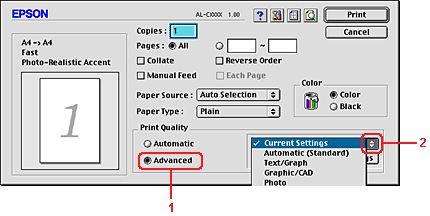
 |
Select the most appropriate setting from the list according to the type of document or image you want to print.
|
For Mac OS X users
 |
Open the Print dialog box.
|
 |
Select Printer Settings from the drop-down list, and select Basic settings tab.
|
 |
Select Advanced. You will find the predefined settings in the list on the right of Automatic.
|
 |
Select the most appropriate setting from the list according to the type of document or image you want to print.
|
When you choose a predefined setting, other settings such as Printing Mode, Resolution, Screen, and Color Management are set automatically. Changes are shown in the Summary drop-down list in the Print dialog box (Mac OS X), or in the current settings list on the left of the Basic Settings dialog box (Mac OS 9).
This printer driver provides the following predefined settings:
Automatic (Standard)
Suitable for regular printing, especially photos.
Text/Graph
Suitable for printing documents that include text and graphs, such as presentation documents.
Graphic/CAD
Suitable for printing graphs and charts.
Photo
Suitable for printing photos.
PhotoEnhance4
Suitable for printing images captured using the video input, a digital camera, or scanner. EPSON PhotoEnhance4 automatically adjusts the contrast, saturation, and brightness of the original image data to produce sharper, more vivid color printouts. This setting does not affect your original image data.
 |
Note:
|
 | |
This function is not available with Mac OS X.
|
|
ColorSync
Automatically adjusts printout colors to match colors on your screen.
Automatic (High Quality)
Suitable for regular printing that gives priority to high-quality printing.
Advanced Text/Graph
Suitable for printing high-quality presentation documents that include text and graphs.
Advanced Graphic/CAD
Suitable for printing high-quality graphs, charts, and photos.
Advanced Photo
Suitable for printing high-quality scanned photos and digitally-captured images.
Customizing print settings
Many users will never need to make their own print settings manually. However, your printer provides for customized print settings if you need more control over the printout, want to make the most detailed settings available, or just want to experiment.
Follow the steps below to customize your print settings.
 |
Open the Basic Settings dialog box.
|
 |
Click Advanced, then click More Settings. The following dialog box appears.
|
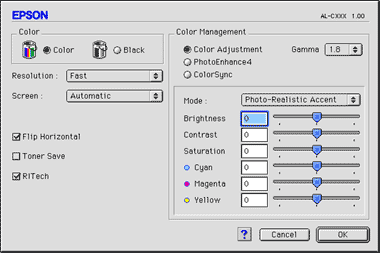
 |
Choose Color or Black as the Color setting.
|
 |
Choose desired printing resolution from Fast (300 dpi) or Fine (600 dpi).
|
 |  |
Note:
|
 |  |
When making the other settings, see the  button for details on each settings. button for details on each settings.
|
|
 |
Click OK to apply the settings and return to the Basic Settings dialog box.
|
 |  |
Note:
|
 |  | |
For details on each settings, see the Online help.
|
|
Saving your settings
To save your custom settings, select Advanced, then click Save Settings on the Basic Settings dialog box. The Custom Settings dialog box appears.
Type a name for your custom settings in the Name box, click Save. Your settings will appear in the list on the right of Automatic in the Basic Settings dialog box.
 |
Note:
|
 | -
You cannot use a predefined setting name for your custom settings.
|
|
 | -
To delete a custom setting, select Advanced, click Save Settings on the Basic Settings dialog box, select the setting in the User Settings dialog box, then click Delete.
|
|
 | -
You cannot delete predefined settings.
|
|
If you change any setting in the Advanced Settings dialog box when one of your custom settings is selected in the Advanced Settings list on the Basic Settings dialog box, the setting selected in the list changes to User Settings. The custom setting that was previously selected is not affected by this change. To return to your custom setting, simply reselect it from the current settings list.
For Mac OS X users
Use the following procedures to save your custom settings.
For Mac OS 10.1.x users, save your custom settings in Save Custom Setting. Your settings will be saved as Custom in the Preset drop-down list. You can save only one set of custom settings.
For Mac OS 10.2 or 10.3 users, save your custom settings in Save Custom Setting. Type a name for your custom settings in the name box. Your settings will be saved with this name in the Preset drop-down list.
 |
Note:
|
 | |
The Custom Setting option is a standard feature of Mac OS X.
|
|

[Top]
Resizing printouts
The Fit to Page function in the Layout dialog box allows you to have your documents enlarged or reduced during printing according to the specified paper size.
 |
Note:
|
 | -
This function is not available with Mac OS X.
|
|
 | -
The enlarging or reducing rate is automatically specified according to the paper size selected in the Paper Setting dialog box.
|
|
 | -
The modifying or reducing rate selected in the Paper Setting dialog box is not available.
|
|
 |
Click the  Layout icon on the Basic Settings dialog box. The Layout dialog box appears. Layout icon on the Basic Settings dialog box. The Layout dialog box appears.
|
 |
Select the Fit to Page check box, then select the desired paper size from the Output Paper drop-down list. The page will be printed to fit on the paper you have selected.
|
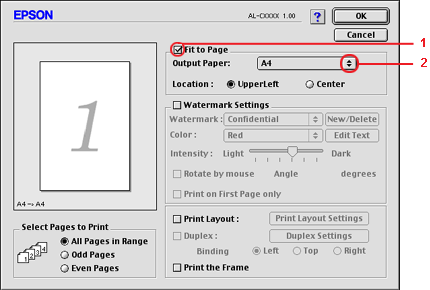
 |
Click OK to apply the settings.
|

[Top]
Modifying the print layout
You can print either two or four pages onto a single page and to specify the printing order, automatically resizing each page to fit the specified paper size by using Layout printing. You can also choose to print documents surrounded by a frame.
 |
Click the  Layout icon on the Basic Settings dialog box. The Layout dialog box appears. Layout icon on the Basic Settings dialog box. The Layout dialog box appears.
|
 |
Select the Print Layout check box, then click Print Layout Settings. The Print Layout Setting dialog box appears.
|
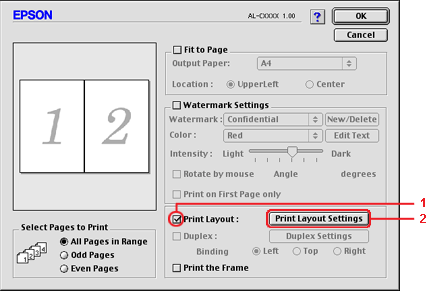
 |
Select the number of pages you want to print on one sheet of paper.
|
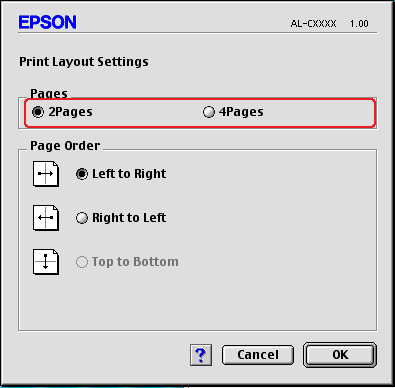
 |
Select the page order in which the pages are printed on each sheet.
|
 |  |
Note:
|
 |  | |
Page Order choices depend on Pages selected above, and Orientation.
|
|
 |
Click OK to apply the settings and return to the Layout dialog box.
|
 |
Select the Print the Frame check box on the Layout dialog box when you want to print the pages surrounded by a frame.
|
 |
Click OK to apply the settings.
|
For Mac OS X users
 |
Open the Print dialog box.
|
 |
Select Layout from the drop-down list.
|
 |
Select the number of page you want to print on one sheet of paper from the drop-down list.
|
 |
Click Print to start printing.
|
 |  |
Note:
|
 |  | |
The Layout settings are a standard feature of Mac OS X.
|
|

[Top]
Using a watermark
Follow the steps below to use a watermark on your document. In the Layout dialog box, you can select from a list of predefined watermarks, or you can select a bitmap (PICT) file or text file as your own custom watermark. The Layout dialog box also allows you to make a variety of detailed watermark settings. For example, you can select the size, intensity, and position of your watermark.
 |
Note:
|
 | |
This function is not available with Mac OS X.
|
|
 |
Click the  Layout icon on the Basic Settings dialog box. The Layout dialog box appears. Layout icon on the Basic Settings dialog box. The Layout dialog box appears.
|
 |
Select the Watermark Settings check box, then a watermark from the Watermark drop-down list.
|
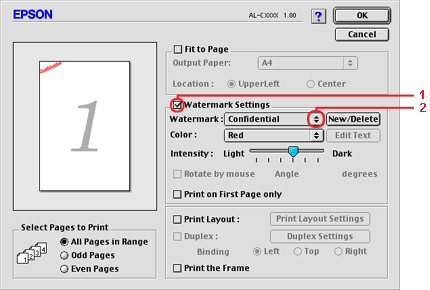
 |
Select the location on the page where you want to print the watermark by dragging the watermark image on the preview window. Also, when you want to resize the watermark, drag its handle.
|
 |
Adjust the image intensity of the watermark with the Intensity slider bar.
|
 |
For your own custom text watermark, you can rotate it by inputting the degrees in the Angle box. Or select the Rotate by mouse check box, then rotate the text watermark with the pointer on the preview window.
|
 |
Click OK to apply the settings.
|
Making a new watermark
You can make a new text or bitmap watermark with the following procedures.
To make a text watermark
 |
Click the  Layout icon on the Basic Settings dialog box. The Layout dialog box appears. Layout icon on the Basic Settings dialog box. The Layout dialog box appears.
|
 |
Select the Watermark Settings check box, then click New/Delete. The Custom Watermark dialog box appears.
|
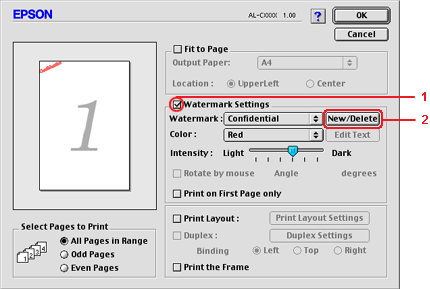
 |
Click Add Text on the Custom Watermark dialog box.
|
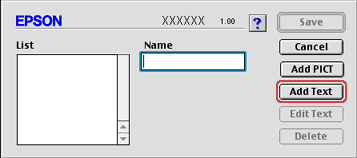
 |
Type the watermark text in the Text box, select the Font and Style, then click OK on the Text Watermark dialog box.
|
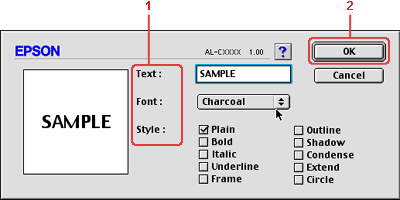
 |
Type the file name in the Name box, then click Save.
|
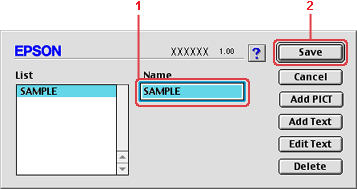
 |  |
Note:
|
 |  | -
To edit the saved text watermark, select it from the List box, then click Edit Text. After editing, be sure to click OK to close the dialog box.
|
|
 |  | -
To remove the saved text watermark, select it from the List box, then click Delete. After removing it, be sure to click Save to close the dialog box.
|
|
 |
Select the saved custom watermark from the Watermark drop-down list on the Layout dialog box, then click OK.
|
To make a bitmap watermark
Before making a custom watermark, you should prepare a bitmap (PICT) file.
 |
Click the  Layout icon on the Basic Settings dialog box. The Layout dialog box appears. Layout icon on the Basic Settings dialog box. The Layout dialog box appears.
|
 |
Select the Watermark Settings check box, then click New/Delete. The Custom Watermark dialog box appears.
|

 |
Click Add PICT on the Custom watermark dialog box.
|
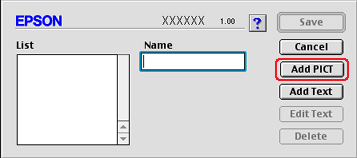
 |
Select the PICT file, then click Open.
|
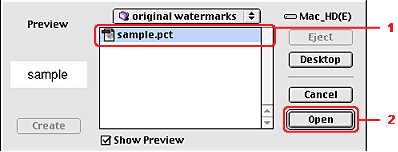
 |
Type the file name in the Name box, then click Save.
|
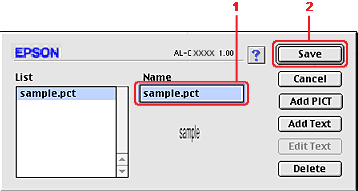
 |  |
Note:
|
 |  | |
To remove the saved watermark, select it from the List box, then click Delete. After removing it, be sure to click Save to close the dialog box.
|
|
 |
Select the saved custom watermark from the Watermark drop-down list on the Layout dialog box, then click OK.
|

[Top]
Printing with the duplex unit
Duplex printing prints on both sides of the paper. When printing for binding, the binding edge can be specified as required to produce the desired page order.
As an ENERGY STAR® partner, Epson recommends the use of the double-sided printing function. Refer to ENERGY STAR® Compliance for more information on the ENERGY STAR® program.
 |
Click the  Layout icon on the Basic Settings dialog box. The Layout dialog box appears. Layout icon on the Basic Settings dialog box. The Layout dialog box appears.
|
 |
Select the Duplex check box.
|
 |
Select a Binding position from Left, Top, or Right.
|
 |
Click Duplex Settings to open the Duplex Settings dialog box.
|
 |
Specify the Binding Margin for the front and back sides of the paper.
|
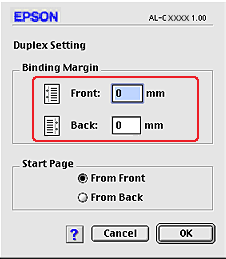
 |
Select whether the front or back side of the paper is to be printed as the Start Page.
|
 |
Click OK to apply the settings and return to the Layout dialog box.
|
For Mac OS X users
 |
Open the Print dialog box.
|
 |
Select Duplex Settings from the drop-down list.
|
 |
Select the Duplex Settings check box.
|
 |
Select a Binding position from Left, Top, or Right.
|
 |
Specify the Binding Margin for the front and back sides of the paper.
|
 |
Select whether the front or back side of the paper is to be printed as the Start Page.
|
 |
Click Print to start printing.
|

[Top]
Making Extended Settings
You can make various settings in the Extended Setting dialog box, for example Page Protect. To open the dialog box, click the  Extended Setting icon on the Basic Settings dialog box.
Extended Setting icon on the Basic Settings dialog box.
For Mac OS X users, open the Extension Settings dialog box.
|
a.
|
Offset:
|
|
Makes fine adjustments to the printing position on the front and the back of data on a page in 1 mm increments.
|
|
b.
|
Ignore the selected paper size check box:
|
|
When you select this check box, the printer prints on loaded paper, regardless of size.
|
|
c.
|
Skip Blank Page check box:
|
|
When you select this check box, the printer skips blank pages.
 |
Note:
|
 | |
This function is not available with Mac OS X.
|
|
|
|
d.
|
Automatically change to monochrome mode check box:
|
|
Select this check box to have the printer driver analyze the printing data, and automatically switch to monochrome mode if the printing data is black and white.
 |
Note:
|
 | |
This function is not available with Mac OS X.
|
|
|
|
e.
|
Adjust line thickness check box:
|
|
Adjusts the width of the lines printed.
 |
Note:
|
 | |
This function is not available with Mac OS X.
|
|
|
|
|
Auto Continue check box:
|
|
When you select this check box, the printer continues to print ignoring the page size errors and memory shortage.
|
|
|
Avoid Page Error check box:
|
|
Select this check box to avoid Print Overrun errors when printing data which requires a lot of memory to print, such as documents with a large number of complex fonts or graphics. Doing so may slow down printing somewhat.
|
|
f.
|
Default button:
|
|
For Mac OS 9 users, click this button to return the settings in the Temporary Spool Folder to the initial settings.
For Mac OS X users, click this button to return the driver settings to the initial settings.
|
|
g.
|
Select button:
|
|
Selects spool file saving folder.
 |
Note:
|
 | |
This function is not available with Mac OS X.
|
|
|
|
h.
|
Cancel button:
|
|
Click this button to exit the dialog box or printer driver without saving the settings.
|
|
i.
|
OK button:
|
|
Click this button to save the settings and to exit the dialog box or printer driver. The settings are effective until you make new settings, then click OK again.
 |
Note:
|
 | |
This function is not available with Mac OS X.
|
|
|

[Top]
| Version NPD0667-01, Copyright © 2004, SEIKO EPSON CORPORATION |
Making the print quality settings
Resizing printouts
Modifying the print layout
Using a watermark
Printing with the duplex unit
Making Extended Settings
Extended Setting icon on the Basic Settings dialog box.